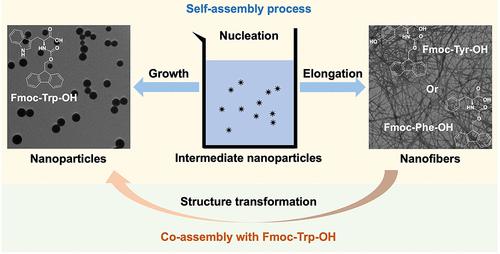当前位置:
X-MOL 学术
›
ACS Appl. Mater. Interfaces
›
论文详情
Our official English website, www.x-mol.net, welcomes your
feedback! (Note: you will need to create a separate account there.)
Structural Transformation of Coassembled Fmoc-Protected Aromatic Amino Acids to Nanoparticles
ACS Applied Materials & Interfaces ( IF 8.3 ) Pub Date : 2024-02-17 , DOI: 10.1021/acsami.3c18463 Tengfei Wang 1 , Cécilia Ménard-Moyon 1 , Alberto Bianco 1
ACS Applied Materials & Interfaces ( IF 8.3 ) Pub Date : 2024-02-17 , DOI: 10.1021/acsami.3c18463 Tengfei Wang 1 , Cécilia Ménard-Moyon 1 , Alberto Bianco 1
Affiliation

|
Materials made of assembled biomolecules such as amino acids have drawn much attention during the past decades. Nevertheless, research on the relationship between the chemical structure of building block molecules, supramolecular interactions, and self-assembled structures is still necessary. Herein, the self-assembly and the coassembly of fluorenylmethoxycarbonyl (Fmoc)-protected aromatic amino acids (tyrosine, tryptophan, and phenylalanine) were studied. The individual self-assembly of Fmoc-Tyr-OH and Fmoc-Phe-OH in water formed nanofibers, while Fmoc-Trp-OH self-assembled into nanoparticles. Moreover, when Fmoc-Tyr-OH or Fmoc-Phe-OH was coassembled with Fmoc-Trp-OH, the nanofibers were transformed into nanoparticles. UV–vis spectroscopy, Fourier transform infrared spectroscopy, and fluorescence spectroscopy were used to investigate the supramolecular interactions leading to the self-assembled architectures. π–π stacking and hydrogen bonding were the main driving forces leading to the self-assembly of Fmoc-Tyr-OH and Fmoc-Phe-OH forming nanofibers. Further, a mechanism involving a two-step coassembly process is proposed based on nucleation and elongation/growth to explain the structural transformation. Fmoc-Trp-OH acted as a fiber inhibitor to alter the molecular interactions in the Fmoc-Tyr-OH or Fmoc-Phe-OH self-assembled structures during the coassembly process, locking the coassembly in the nucleation step and preventing the formation of nanofibers. This structural transformation is useful for extending the application of amino acid self- or coassembled materials in different fields. For example, the amino acids forming nanofibers could be applied for tissue engineering, while they could be exploited as drug nanocarriers when they form nanoparticles.
中文翻译:

共组装 Fmoc 保护的芳香氨基酸向纳米颗粒的结构转化
在过去的几十年里,由氨基酸等生物分子组装而成的材料引起了人们的广泛关注。尽管如此,对构件分子的化学结构、超分子相互作用和自组装结构之间的关系的研究仍然是必要的。在此,研究了芴甲氧基羰基(Fmoc)保护的芳香族氨基酸(酪氨酸、色氨酸和苯丙氨酸)的自组装和共组装。 Fmoc-Tyr-OH和Fmoc-Phe-OH在水中单独自组装形成纳米纤维,而Fmoc-Trp-OH自组装成纳米颗粒。此外,当Fmoc-Tyr-OH或Fmoc-Phe-OH与Fmoc-Trp-OH共组装时,纳米纤维转化为纳米颗粒。紫外可见光谱、傅里叶变换红外光谱和荧光光谱用于研究导致自组装结构的超分子相互作用。 π-π堆积和氢键是导致Fmoc-Tyr-OH和Fmoc-Phe-OH自组装形成纳米纤维的主要驱动力。此外,提出了一种基于成核和伸长/生长的两步共组装过程的机制来解释结构转变。 Fmoc-Trp-OH 充当纤维抑制剂,在共组装过程中改变 Fmoc-Tyr-OH 或 Fmoc-Phe-OH 自组装结构中的分子相互作用,将共组装锁定在成核步骤中并防止纳米纤维的形成。这种结构转变有助于扩展氨基酸自组装或共组装材料在不同领域的应用。例如,形成纳米纤维的氨基酸可以应用于组织工程,而当它们形成纳米颗粒时可以用作药物纳米载体。
更新日期:2024-02-17
中文翻译:

共组装 Fmoc 保护的芳香氨基酸向纳米颗粒的结构转化
在过去的几十年里,由氨基酸等生物分子组装而成的材料引起了人们的广泛关注。尽管如此,对构件分子的化学结构、超分子相互作用和自组装结构之间的关系的研究仍然是必要的。在此,研究了芴甲氧基羰基(Fmoc)保护的芳香族氨基酸(酪氨酸、色氨酸和苯丙氨酸)的自组装和共组装。 Fmoc-Tyr-OH和Fmoc-Phe-OH在水中单独自组装形成纳米纤维,而Fmoc-Trp-OH自组装成纳米颗粒。此外,当Fmoc-Tyr-OH或Fmoc-Phe-OH与Fmoc-Trp-OH共组装时,纳米纤维转化为纳米颗粒。紫外可见光谱、傅里叶变换红外光谱和荧光光谱用于研究导致自组装结构的超分子相互作用。 π-π堆积和氢键是导致Fmoc-Tyr-OH和Fmoc-Phe-OH自组装形成纳米纤维的主要驱动力。此外,提出了一种基于成核和伸长/生长的两步共组装过程的机制来解释结构转变。 Fmoc-Trp-OH 充当纤维抑制剂,在共组装过程中改变 Fmoc-Tyr-OH 或 Fmoc-Phe-OH 自组装结构中的分子相互作用,将共组装锁定在成核步骤中并防止纳米纤维的形成。这种结构转变有助于扩展氨基酸自组装或共组装材料在不同领域的应用。例如,形成纳米纤维的氨基酸可以应用于组织工程,而当它们形成纳米颗粒时可以用作药物纳米载体。































 京公网安备 11010802027423号
京公网安备 11010802027423号